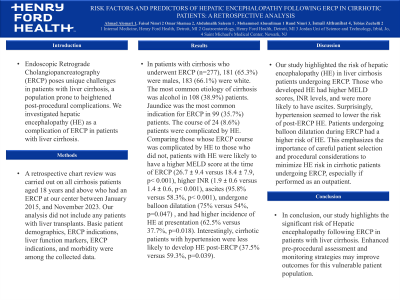Monday Poster Session
Category: Liver
P2934 - Risk Factors and Predictors of Hepatic Encephalopathy Following ERCP in Cirrhotic Patients: A Retrospective Analysis
Monday, October 28, 2024
10:30 AM - 4:00 PM ET
Location: Exhibit Hall E

Has Audio

Ahmad Alomari, MD
Henry Ford Hospital
Detroit, MI
Presenting Author(s)
Ahmad Alomari, MD1, Faisal Nimri, MD1, Omar Shamaa, MD2, Abdulmalik Saleem, MD2, Mohammed Abusuliman, MD2, Rund Nimri, MD3, Ismail Althunibat, MD4, Tobias Zuchelli, MD1
1Henry Ford Hospital, Detroit, MI; 2Henry Ford Health, Detroit, MI; 3Jordan University of Science and Technology, Irbid, Irbid, Jordan; 4Saint Michael's Medical Center, Newark, NJ
Introduction: Endoscopic Retrograde Cholangiopancreatography (ERCP) poses unique challenges in patients with liver cirrhosis, a population prone to heightened post-procedural complications. We investigated hepatic encephalopathy (HE) as a complication of ERCP in patients with liver cirrhosis.
Methods: A retrospective chart review was carried out on all cirrhosis patients aged 18 years and above who had an ERCP at our center between January 2015, and November 2023. Our analysis did not include any patients with liver transplants. Basic patient demographics, ERCP indications, liver function markers, ERCP indications, and morbidity were among the collected data.
Results: In patients with cirrhosis who underwent ERCP (n=277), 181 (65.3%) were males, 183 (66.1%) were white. The most common etiology of cirrhosis was alcohol in 108 (38.9%) patients. Jaundice was the most common indication for ERCP in 99 (35.7%) patients. The course of 24 (8.6%) patients were complicated by HE. Comparing those whose ERCP course was complicated by HE to those who did not, patients with HE were likely to have a higher MELD score at the time of ERCP (26.7 ± 9.4 versus 18.4 ± 7.9, p< 0.001), higher INR (1.9 ± 0.6 versus 1.4 ± 0.6, p< 0.001), ascites (95.8% versus 58.3%, p< 0.001), undergone balloon dilatation (75% versus 54%, p=0.047) , and had higher incidence of HE at presentation (62.5% versus 37.7%, p=0.018). Interestingly, cirrhotic patients with hypertension were less likely to develop HE post-ERCP (37.5% versus 59.3%, p=0.039).
Discussion: Our study highlighted the risk of hepatic encephalopathy (HE) in liver cirrhosis patients undergoing ERCP. Those who developed HE had higher MELD scores, INR levels, and were more likely to have ascites. Surprisingly, hypertension seemed to lower the risk of post-ERCP HE. Patients undergoing balloon dilatation during ERCP had a higher risk of HE. This emphasizes the importance of careful patient selection and procedural considerations to minimize HE risk in cirrhotic patients undergoing ERCP, especially if performed as an outpatient.
Disclosures:
Ahmad Alomari, MD1, Faisal Nimri, MD1, Omar Shamaa, MD2, Abdulmalik Saleem, MD2, Mohammed Abusuliman, MD2, Rund Nimri, MD3, Ismail Althunibat, MD4, Tobias Zuchelli, MD1. P2934 - Risk Factors and Predictors of Hepatic Encephalopathy Following ERCP in Cirrhotic Patients: A Retrospective Analysis, ACG 2024 Annual Scientific Meeting Abstracts. Philadelphia, PA: American College of Gastroenterology.
1Henry Ford Hospital, Detroit, MI; 2Henry Ford Health, Detroit, MI; 3Jordan University of Science and Technology, Irbid, Irbid, Jordan; 4Saint Michael's Medical Center, Newark, NJ
Introduction: Endoscopic Retrograde Cholangiopancreatography (ERCP) poses unique challenges in patients with liver cirrhosis, a population prone to heightened post-procedural complications. We investigated hepatic encephalopathy (HE) as a complication of ERCP in patients with liver cirrhosis.
Methods: A retrospective chart review was carried out on all cirrhosis patients aged 18 years and above who had an ERCP at our center between January 2015, and November 2023. Our analysis did not include any patients with liver transplants. Basic patient demographics, ERCP indications, liver function markers, ERCP indications, and morbidity were among the collected data.
Results: In patients with cirrhosis who underwent ERCP (n=277), 181 (65.3%) were males, 183 (66.1%) were white. The most common etiology of cirrhosis was alcohol in 108 (38.9%) patients. Jaundice was the most common indication for ERCP in 99 (35.7%) patients. The course of 24 (8.6%) patients were complicated by HE. Comparing those whose ERCP course was complicated by HE to those who did not, patients with HE were likely to have a higher MELD score at the time of ERCP (26.7 ± 9.4 versus 18.4 ± 7.9, p< 0.001), higher INR (1.9 ± 0.6 versus 1.4 ± 0.6, p< 0.001), ascites (95.8% versus 58.3%, p< 0.001), undergone balloon dilatation (75% versus 54%, p=0.047) , and had higher incidence of HE at presentation (62.5% versus 37.7%, p=0.018). Interestingly, cirrhotic patients with hypertension were less likely to develop HE post-ERCP (37.5% versus 59.3%, p=0.039).
Discussion: Our study highlighted the risk of hepatic encephalopathy (HE) in liver cirrhosis patients undergoing ERCP. Those who developed HE had higher MELD scores, INR levels, and were more likely to have ascites. Surprisingly, hypertension seemed to lower the risk of post-ERCP HE. Patients undergoing balloon dilatation during ERCP had a higher risk of HE. This emphasizes the importance of careful patient selection and procedural considerations to minimize HE risk in cirrhotic patients undergoing ERCP, especially if performed as an outpatient.
Disclosures:
Ahmad Alomari indicated no relevant financial relationships.
Faisal Nimri indicated no relevant financial relationships.
Omar Shamaa indicated no relevant financial relationships.
Abdulmalik Saleem indicated no relevant financial relationships.
Mohammed Abusuliman indicated no relevant financial relationships.
Rund Nimri indicated no relevant financial relationships.
Ismail Althunibat indicated no relevant financial relationships.
Tobias Zuchelli: Boston Scientific – Consultant.
Ahmad Alomari, MD1, Faisal Nimri, MD1, Omar Shamaa, MD2, Abdulmalik Saleem, MD2, Mohammed Abusuliman, MD2, Rund Nimri, MD3, Ismail Althunibat, MD4, Tobias Zuchelli, MD1. P2934 - Risk Factors and Predictors of Hepatic Encephalopathy Following ERCP in Cirrhotic Patients: A Retrospective Analysis, ACG 2024 Annual Scientific Meeting Abstracts. Philadelphia, PA: American College of Gastroenterology.
